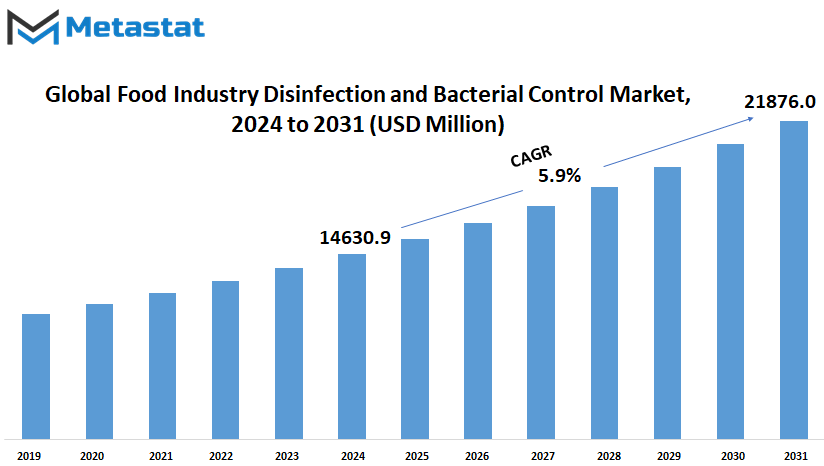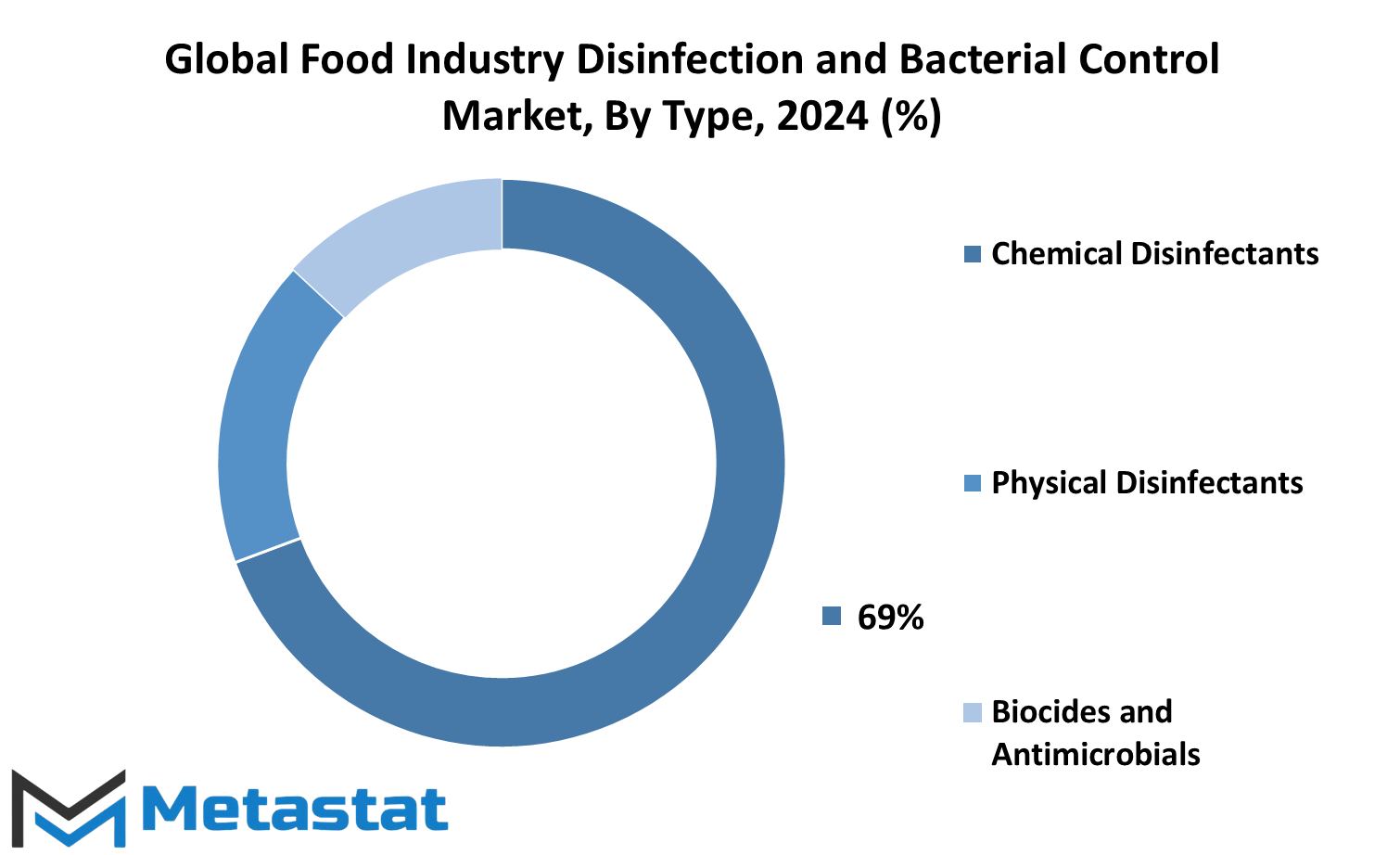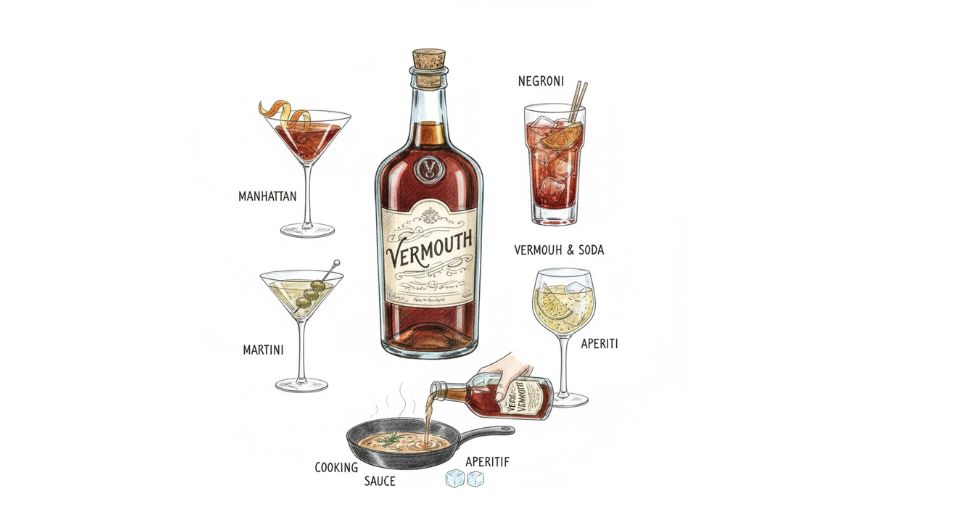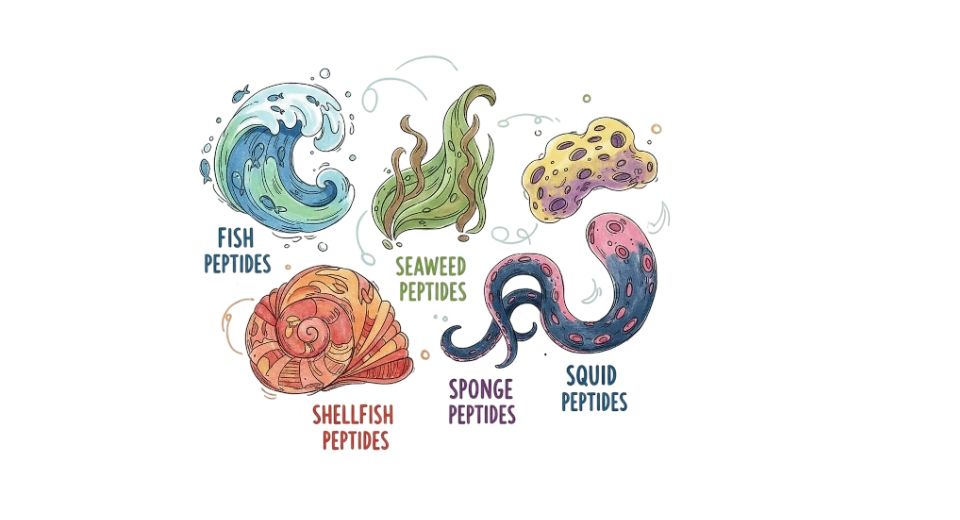MARKET OVERVIEW
The Global Food Industry Disinfection and Bacterial Control market forms a part of the food industry, since it is concerned with maintaining the quality and safety of food produced for human consumption worldwide. It is involved in the development and application of advanced techniques and products for the elimination of pathogenic microorganisms from environments where food is produced. There is a constant quest for better disinfection and bacterial control solutions, considering that many complications in public health can be triggered by foodborne infections and poisoning.
The disinfection equipment, chemical agents, and monitoring systems offered in this market are applied to maintain the hygienic standards in various segments. The enhanced focus on food safety has brought about the establishment of tight regulations and guidelines, which have then pushed many food manufacturers to apply strong disinfection and bacterial control measures. These measures protect not only the consumers but also boost the reputation and credibility of food brands.
Of course, it is innovative technologies that are leading the charge in the development of disinfection techniques in this. Some advanced methods include UV radiation, ozone processing, and electrostatic spraying, which have found entry into food processing facilities. Taking the place of traditional chemical disinfectants, these technologies offer efficient and environmentally friendly alternatives. By reducing reliance on chemicals, this industry strives to minimize environmental impact while ensuring thorough bacterial control.
However, their wide application still persists due to the effectiveness of these chemical disinfectants. Quaternary ammonium compounds, chlorine-based disinfectants, and hydrogen peroxide solutions find broad application for surface and equipment disinfection purposes. As a result, successive improvisations and optimization in the development of these chemicals have been ongoing to provide better efficacy and safety profiles in the Global Food Industry Disinfection and Bacterial Control market. Investments by manufacturers into research and development are geared toward producing formulations that are less likely to have as much impact on the environment and human health as before, without actually sacrificing disinfection power. Another critical factor that drives this market is monitoring systems, providing real-time data on hygiene levels within food production facilities.
These systems make use of sensors along with advanced analytics to detect bacterial contamination, thereby allowing for real-time corrective actions to take place. The integration of IoT and AI in monitoring systems is touted to transform the global food industry disinfection and bacterial control market. These technologies will make possible predictive maintenance and early issue detection, drastically reducing the risks of contamination. With growing consumer awareness about the safety of food, there is a greater demand for transparency and accountability in food production. The adoption of blockchain technology for keeping track of and verifying the various disinfection processes along the supply chain is likely to increase in the Global Food Industry Disinfection and Bacterial Control market. This will give consumers assurance about the safety and quality of the food they consume. The globalization of the food supply chain adds another layer of complexity to the effort of disinfection and control. Food products are moving across borders, and it becomes really hard to maintain homogeneous hygiene standards. The Global Food Industry Disinfection and Bacterial Control Market will develop in terms of standardized protocols and international collaborations to help offset these challenges.
The future of the Global Food Industry Disinfection and Bacterial Control market looks promising, as continuous innovations and technological developments come into the pipeline. This commitment by the industry towards food safety shall grow further in the adoption of new disinfection methods, better chemical formulations, and advanced monitoring systems. In view of an increasing global population and food production scaling up, the significance of this market shall rise manifold to ensure public health and consumer confidence in the food supply chain.
Global Food Industry Disinfection and Bacterial Control market is estimated to reach $21876.0 Million by 2031; growing at a CAGR of 5.9% from 2024 to 2031.

GROWTH FACTORS
The factors responsible for this growth in the Global Food Industry Disinfection and Bacterial Control market are increased awareness about food safety among consumers and strict government regulations. The ever-increasing cases of foodborne illnesses across the world have, therefore, compelled the key players in the food industry to focus on disinfection and bacterial control measures.
Improvements in technology significantly contribute to increasing efficiency with regard to food industry disinfection processes. New disinfectants and sanitizers, developed for use in food processing environments, ensure higher efficacy and standards of safety. These developments enhance operational efficiencies while reducing health risks due to contaminated food products.
On the contrary, the growth of the market is hindered by regulatory complexities and high cost associated with advanced disinfection technologies. Keeping up with different regulatory requirements in various regions is time-consuming, may be very expensive, and requires proper investment and skill. Furthermore, set-up costs of the advanced disinfection technologies are quite unaffordable for small and medium-sized enterprises, thus limiting the growth of the market to an extent.
The Global Food Industry Disinfection and Bacterial Control market holds promising opportunities. Increasingly, adoption of automation and robotics within food processing plants is likely to make disinfection procedures easier and cost-effective. Further, investments in R&D toward more eco-friendly disinfection solutions will set the basis for growth in the market.
Growing concern for food safety among consumers compels food manufacturers to follow hygiene practices. This strict move towards hygiene standards paves the way for market growth. Again, the outbreak of the COVID-19 pandemic promotes hygiene awareness across industries, including food, which further increases the demand for effective disinfection solutions.
Even though some restraints, such as regulatory hurdles and the high costs of such products, are involved in the Global Food Industry Disinfection and Bacterial Control market, there is still a great opportunity for growth. Technology developments, compliance with regulations, and changing consumer preferences related to the use of safe food products will all ultimately have an effect on long-term market growth. Innovative ways to develop disinfection technologies, along with key investments in research and development, hold the promise of unlocking new opportunities that lie within the market landscape. In the process of evolution of this industry, all those stakeholders who intend to cash in on the enhanced market potential shall have to leverage these growth factors.
MARKET SEGMENTATION
By Type
The global food industry disinfection and bacterial control market forms the backbone of food safety and quality security in the world. In terms of application, the global food industry disinfection and bacterial control market comes forth with a bunch of products aimed at protecting from bacterial contamination during different stages of food processing.
They are basically segmented into chemical disinfectants, physical disinfectants, biocides, and antimicrobials. Chemical Disinfectants: These are some specific chemical agents which help kill bacteria and other microorganisms. They are majorly used in food processing plants for sanitization purposes of equipment and all surfaces that come in contact with food products.
The physical ones, however, rely on physical processes like heat or ultraviolet light in ridding the bacteria. These are with marked effectiveness and often used in conjunction with chemical disinfectants to ensure a comprehensive type of microbial control.
Biocides are broad-ranging substances aimed at destroying, deterring, or rendering harmless microorganisms. Their application does not stop at the production level; it is also applied in storage and during transportation to make sure that food stays safe throughout the supply line. Another class includes antimicrobials, which not only target microorganisms but work to inhibit their growth, hence preventing contamination.
Next-generation biocides and antimicrobials would most probably get developed on the parameters of effectiveness and specificity to have no kind of impacts on the quality and safety of foods, though providing targeted microbial control. Increasing demand for the production of risk-free and high-quality food products globally would propel manufacturers and thus add to market growth for more advanced solution development.

By Application
Food safety and quality are very essential in the present world. Global Food Industry Disinfection and Bacterial Control insists on this critical need, satisfying it with different applications. These include food processing equipment surface disinfection, food preparation areas surface disinfection, storage areas surface disinfection, anti-microbial coatings food preservation, and preservative solutions food preservation.
The global food industry disinfection and bacterial control market is growing rapidly. With the rising concerns for foodborne illnesses and safer ways of handling food, manufacturers are coming up with innovations to answer these needs. This includes innovating advanced technologies for surface disinfecting and preservation of food products.
Food processing equipment is thus subjected to intensive cleaning to make sure that contamination is prevented. Surface disinfection of food preparation areas provides for hygiene practices right from the very basic beginning of food handling. Disinfection in storage areas consequently safeguards the quality and safety of food all the way through the supply chain.
Fresh food products now stand to gain from antimicrobial coatings that will extend their shelf life. Such coatings prevent any growth of bacteria and fungi, thereby reducing the development of off-flavors and odors leading to food spoilage, and thus, waste. Preservative solutions continue to give a more advanced way of preserving food by controlling microbial growth without interfering with its taste or nutritional value.
By End User
The Global Food Industry Disinfection and Bacterial Control market spans a wide range of sectors in maintaining food safety. By addressing end users in the Meat and Poultry Processing, Dairy Processing, Seafood Processing, Bakery and Confectionery, Restaurants, Commercial Kitchens, and Food Service Providers industries, diverse needs are addressed in sustaining hygiene standards.
In the Meat and Poultry Processing segment, one will wish to emphasize strict disinfection practices with the view of preventing contamination and ensuring the safety of the meat products. This means frequent and correct cleaning of equipment and facilities for processing to reduce bacterial risks along the value chain of production.
Moreover, dairy-processing plants have to adhere to strict decontamination procedures for the quality and safety of the products to be maintained. Efficient disinfection measures kill bacteria and attain the hygiene levels needed for such processing.
In seafood processing, the challenges are different since the products processed are of a perishable nature. In this regard, proper disinfection measures would control bacterial growth in the processing and storage of seafood products for freshness and safety.
Hygiene is very important in bakery and confectionery works to avoid contamination by microorganisms that will be to the detriment of product quality. In this regard, disinfection measures are put in place to ensure that the baking equipment and facilities are clean and the products realize and maintain integral value in bakery and confectionery.
The fight to stay clean in restaurants and commercial kitchens is a daily one to ensure foodborne illness protection. In this way, good disinfection practices become imperative for maintaining high standards of sanitation and also for ensuring consumer protection against bacterial dangers involved with food preparation and service.
Food Service Establishments are broad and encompass food service establishments, catering services, and institutional food facilities. Compliance with disinfection practices is crucial for both regulatory compliance and consumer acceptance of food safety emanating from the wide array of foodservice establishments.
Further growth of the global food industry disinfection and bacterial control market shall continue to take the bias of technological progress and improvement of sanitation practices. Improvisation on disinfection methods and equipment will facilitate better efficiency and measures of bacterial control in diversified food processing and service sectors.
By Sales Channel
The global disinfection and bacterial control in the food industry is going to flourish in huge amounts. Now, if we come to the sales channel in the market, it includes online and offline, through which we can understand the future prospects of this particular market.
The food industry disinfection and bacterial control market is rapidly growing in different geographic regions. This can be attributed to the increasing consciousness of customers and regulatory bodies related to food safety. More stringent regulations that are coming into effect globally raise demand for effective disinfection solutions all along the food supply chain.
Online sales channels are of further importance in this market. The convenience and reach provided by online channels make it easier for food industry professionals to source disinfection and bacterial control products without much hassle. This trend is going to accelerate as digitalization further gains a foothold in the industry, allowing speedier transactions and access to an array of products that meet specific needs.
Equally important are the offline sales channels, such as traditional retail outlets and distributors. These provide a chance for direct interaction with the products to be sold, in which buyers would have an opportunity to check the quality and suitability of the products. In spite of the boom in online platforms, most consumers and businesses still trust and believe in the assurance and touch associated with offline channels.
The technological development that will set the pace in influencing the market looking forward is, therefore, likely to be led by automated disinfection systems and green solutions. These developments enhance efficacy but also show growing concerns over the environmental impact that results from chemical disinfectants used in the food industry.
REGIONAL ANALYSIS
In these geographical regions, the food industry disinfection and bacterial control market is analyzed: North America, Europe, Asia-Pacific, South America, and Middle East & Africa. All these regions act as major contributors to changing the dynamics of the market.
The regional market in North America, including the U.S., Canada, and Mexico, is expected to enjoy high market share because of stringent regulatory frameworks and high-tech adoption in food processing. Rising awareness regarding food safety and quality by effective disinfection techniques shall drive the growth of the regional market.
Europe alone, with the UK, Germany, France, Italy, and others, is a huge market with its infrastructure in place as far as the food industry is concerned. Stringent hygiene standards, coupled with consumer awareness of foodborne illnesses, drive demand for better disinfection solutions across food processing facilities.
The Asia-Pacific region comprises developing economies such as India and established ones like China, Japan, and South Korea. Fast-paced industrialization in the food sector here drives demand for better disinfection measures and bacterial controls. This report covers region-wise segmentation of the global food safety testing market by geography: North America, Europe, Asia-Pacific, Latin America, and Middle East and Africa. The growing food processing industry in the region and increasing concern for food safety will drive market growth.
Lastly, food production and processing capabilities are rapidly growing in countries like Brazil and Argentina in the South American region. Due to the fact that the entire region is striving to achieve global standards of food safety, the usage of disinfection technologies for reducing risks of bacterial contamination is on an increasing note.
With an increasing tide of investment in food processing infrastructure and technologies, the food industry is changing across the Middle East & Africa, including GCC countries, Egypt, and South Africa. The focus has shifted towards hygienic production practices and global food safety standards that drive demand for effective disinfection solutions.
Each region represents different opportunities and challenges that the global Food Industry Disinfection and Bacterial Control market has to face. Developed regions are keener on technological innovation and adhering to regulatory requirements, while developing economies are very much engaged in scaling up food production with an emphasis on maintaining safety standards. Backed by these trends, the future growth prospects of the food industry disinfection and bacterial control market will depend on the level of innovation in disinfection technologies, evolution of the regulatory landscape, and shifting consumer behavior towards the adoption of safe and quality food products.
In view of the ever-increasing consumption of food at a global level, effective disinfection and bacterial control within regional markets will be of vital importance to the continuous upholding of food safety and consumer expectations worldwide.
COMPETITIVE PLAYERS
Core players who drive competition and innovation in the Global Food Industry Disinfection and Bacterial Control Market. They help to guarantee the standards of safety and hygiene that are so critical in food production and processing.
Major players here are Ecolab, Diversey, Inc., 3M Company, Steris PLC, The Clorox Company, SC Johnson Professional USA, Inc., Neogen Corporation, Evonik, Zep Inc., Stepan Company, Kiilto, and Betco Corporation. With its unique knowledge and technologies, each represents best-in-class examples of delivery for the food-processing sector regarding disinfection and control of bacteria.
It extends to the portfolio of Ecolab, the global leader in water, hygiene, and infection prevention solutions, which meets the changing landscape of regulatory and consumer requirements. And Diversey, Inc., well recognized for its comprehensive cleaning and hygiene solutions, believes in sustainability and is taking initiatives toward technological advancement in order to be on par with other companies in this domain.
3M Company leverages its large body of research to develop innovative products that address the stringent disinfection requirements of the food industry. Steris PLC is a global company specializing in sterilization and decontamination solutions. It delivers critical products and services to ensure the food is safe from the farm to the table.
The Clorox Company, having earned a name for itself in the field of "Disinfection and Cleanliness," is entrenched in the market with very high consumer trust in the efficacy of the products. SC Johnson Professional USA, Inc., is engaged in professional cleaning and hygiene solutions with leading credentials in safety and efficacy in both established and new categories.
Neogen Corporation is a company dealing with special food and animal safety products that yield advanced diagnostics and disinfection solutions for the global food industry. Evonik, with chemicals of specialty character, including disinfectants, deals with answering the industry's needs for effective microbial control.
They provide a variety of cleaning and disinfection solutions to respond clearly to the challenges held back in the food processing and manufacturing chain. Stepan also comes into play with innovations and formulation for cleaning to up both operational efficiencies and safety.
Kiilto and Betco Corporation are among the manufacturers and producers of environmentally friendly cleaning solutions with a strong commitment to environmental protection and sustainability in line with food processing greening taking center stage globally.
As the future unfolds, these fiercely competitive players in the global food industry disinfection and bacterial control market are bound to innovate and collaborate in finding solutions related to such emerging challenges as microbial resistance and regulatory changes. Their combined efforts will go on to define the future landscape of food safety, where the rest of the world's consumers will come to rest assured by trusting the integrity and hygiene of food products.
Food Industry Disinfection and Bacterial Control Market Key Segments:
By Type
- Chemical Disinfectants
- Physical Disinfectants
- Biocides and Antimicrobials
By Application
- Food Processing Equipment Surface Disinfection
- Food Preparation Areas Surface Disinfection
- Storage Areas Surface Disinfection
- Anti-microbial Coatings Food Preservation
- Preservative Solutions Food Preservation
By End User
- Meat and Poultry Processing
- Dairy Processing
- Seafood Processing
- Bakery and Confectionery
- Restaurants and Commercial Kitchens
- Food Service Providers
By Sales Channel
- Online
- Offline
Key Global Food Industry Disinfection and Bacterial Control Industry Players
- Ecolab
- Diversey, Inc
- 3M Company
- Steris PLC
- The Clorox Company
- SC Johnson Professional USA, Inc.
- Neogen Corporation
- Evonik
- Zep Inc.
- Stepan Company
- Kiilto
- Betco Corporation
WHAT REPORT PROVIDES
- Full in-depth analysis of the parent Industry
- Important changes in market and its dynamics
- Segmentation details of the market
- Former, on-going, and projected market analysis in terms of volume and value
- Assessment of niche industry developments
- Market share analysis
- Key strategies of major players
- Emerging segments and regional growth potential








 US: +1 3023308252
US: +1 3023308252






